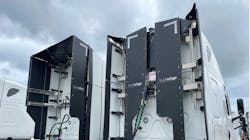Electric Class 8 vehicles have the potential to revolutionize the freight transportation industry, offering zero emissions and significant fuel savings for a cleaner and more sustainable future. However, range anxiety is one major obstacle hindering the widespread adoption of Class 8 electric trucks.
The range of an electric truck is influenced by various factors, including battery size, vehicle weight, and powertrain efficiency. Among these factors, aerodynamics plays a crucial role. Aerodynamic drag refers to the force that opposes the motion of a vehicle through the air. The greater the aerodynamic drag, the more power is required to overcome it, resulting in a shorter range.
See also: TruckLabs hits half-billion-mile mark with aerodynamic device
Optimizing aerodynamic design is particularly vital for electric trucks as losses due to drag cannot be mitigated, unlike how battery weight can be partially offset through regenerative braking. There are plenty of examples of this in passenger EV design—smooth underbody panels to flush door handles—in part made possible by not packaging an internal combustion engine. Consequently, electric trucks must prioritize aerodynamic efficiency to achieve their range targets.
Improving the aerodynamics of an electric truck can be approached in several ways, but one significant opportunity lies in addressing the gap between the tractor and trailer. This gap can create turbulence and drag, leading to a substantial reduction in the range of an electric truck. OEMs have primarily focused their R&D efforts on battery and motor technology based on existing truck platforms. With no changes to the body styling, electric Class 8 aerodynamics are only negatively affected by extended wheelbases and larger tractor-trailer gaps imposed by battery packaging.
Various cost-effective methods can be employed to reduce the gap between the tractor and trailer, such as utilizing aerodynamic fairings or side extenders. However, the most effective solution on an extended wheelbase involves the implementation of a tractor-trailer gap reducer that automatically closes the gap between the cab and trailer, reducing drag, enhancing stability, and increasing the range of electric vehicles.
Matching the heights of the tractor and trailer is another approach to improving aerodynamics. When the tractor and trailer have different heights, the air flowing over the top of the trailer can create turbulence, reducing overall efficiency. By aligning the tractor and trailer heights, the air can flow smoothly over the top, leading to improved range.
Enhancing the aerodynamics of an electric truck with products in the market today has the potential to extend its range by up to 10%. Such an improvement can make a significant difference in the competitiveness of electric trucks against their diesel counterparts. By incorporating these aerodynamic features, truck manufacturers can effectively extend the range of electric Class 8 vehicles, making them a more viable option for fleet operators.
As the electric truck market continues to expand, the importance of aerodynamics will only increase. Truck manufacturers must prioritize aerodynamics to ensure that Class 8 electric trucks meet the requirements of fleet operators and consumers alike.
The adoption of electric Class 8 trucks holds immense potential for the freight transportation industry. However, range anxiety remains a significant challenge. By focusing on improving aerodynamics through measures such as reducing the gap between the tractor and trailer and matching their heights, truck manufacturers can extend the range of electric trucks, enabling them to compete more effectively with diesel-powered trucks.
By prioritizing aerodynamics, the industry can ensure that Class 8 electric trucks fulfill the needs of fleet operators and consumers, driving us closer to a sustainable future in freight transportation.
Andrew Kelly is VP of product for TruckWings at TruckLabs. A former body and aerodynamics design engineer at Honda R&D Americas. He has bachelor's and master's degrees in mechanical Engineering from Johns Hopkins University.
About the Author

Andrew Kelly
Andrew Kelly is VP and product manager at Conmet for the TruckWings product line. He is responsible for product development, sales engineering, and managing the data pipeline for TruckWings. Prior to working with TruckWings, Kelly worked at Honda R&D Americas as a body and aerodynamics design engineer.
